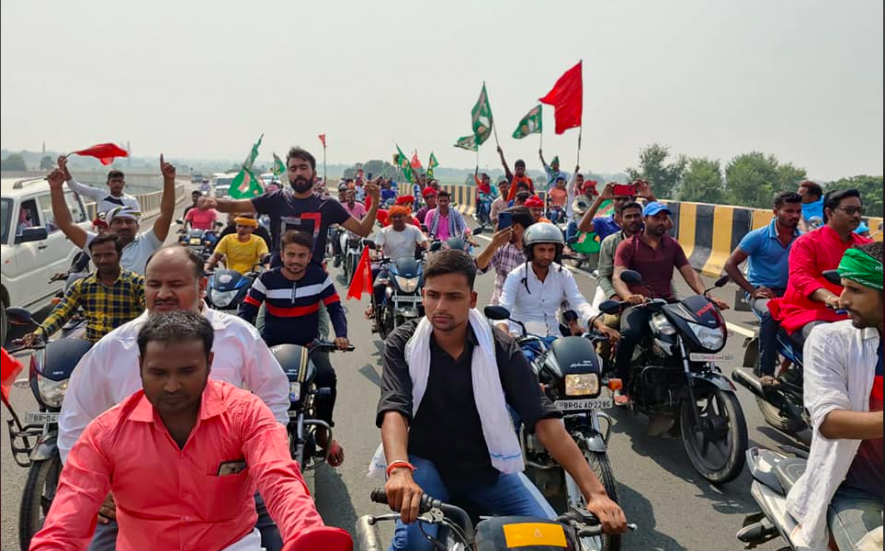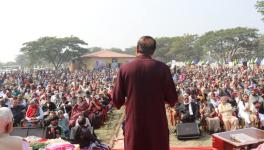Why Tejashwi Should Learn from Left to Build his Party Cadre

A bike rally of Mahagathbandhan candidate in Bihar
Elections are not only fought on issues. Perception plays an equally important role in leading parties to victory or defeat. One can even say elections are broadly contested on the basis of public perception. So, for example, when the Left parties were included in the Grand Alliance, it sent out a positive message to voters. On the other hand, when leaders such as Mukesh Sahni of the Vikassheel Insaan Party (VIP) and Upendra Kushwaha were shown the way out of the Grand Alliance, their exclusion, too, sent out a message. Mukesh Sahni described his exit as a result of being “stabbed in the back”, but the general public reads messages coded into leaders’ decisions in its own way.
Saini’s exit made the public feel as if the leaders of the Rashtriya Janata Dal (RJD) are wary of associating with any leader who is in a position to challenge them. It does not matter that this perception is unfounded, for neither the leaders of VIP nor HAM had challenged RJD’s leadership. Rather, both are parties with which the Grand Alliance had partnered in the last Lok Sabha election. In contrast, Nitish Kumar got Jitan Ram Manjhi’s Hindustani Awam Morcha (HAM) into the NDA fold by allotting it six seats, while the BJP included Sahni with 11 seats after he left the Grand Alliance. In this way, two parties of the Grand Alliance became a part of the NDA. They got tickets to contest from 17 seats and won eight. If you simply add and subtract these eight seats, then the NDA government would have been in a minority, with 117 seats, while the Grand Alliance would have been in a position to get the benefit of one additional seat! Of course, this was not to be. The RJD’s logic was that it is more difficult to keep smaller political outfits in check (or satisfy their demands) once elections are over. Perhaps leaders forget what the public really gleans from such comments, and do not assess just how harmful such a narrative can get.
Still, the messaging is only half the story of an election. Consider some other aspects: even though the NDA is in a position to form government after this election, and the RJD has emerged as the main Opposition party (it got the maximum number of seats at 75), yet the real winner to emerge out of the Bihar polls is the Left parties. This time, 29 seats were allotted to the three Left parties in the Grand Alliance, of which the CPI(ML) contested on 19 seats, the CPI on six seats and the CPI(M) on four. Of these 29 seats, the Left won 16 seats. The ML got 12 seats and the CPI and CPI(M), got two seats each. This is the first such resounding success that the Left parties have tasted since 1990.
Until the nineties, the CPI and CPI(M) had a strong presence in the Bihar Assembly. In 1990, 26 MLAs belonging to Left outfits were elected, including seven from the erstwhile Indian People’s Front or IPF, which was the main political front at the time of the CPIML’s underground. The CPI had 35 MLAs in the 1972 Assembly and was the main Opposition party. Before that, in 1967, the CPI had 22 members, while Ajit Sarkar of the CPI(M), who won from Purnia in the 1990s, and Mahendra Singh of CPI(ML) had almost played the role of a Leader of Opposition in the state Assembly.
To return to the present election, in the first phase of polling, 71 seats went to the polls. Of these, the Grand Alliance won 80% of seats. Whereas, in the 94 seats that were polled during the second phase, this success rate reduced to 50%, which further fell to 30% in the 74 seats of the last phase. The main reason for this is that wherever the communist parties were working at the grass-roots level, they organised voters not only for themselves but also for the other constituent parties of the Alliance. Not just that, they ensured voters were going to the polling booths. As the influence of the Left parties in the second phase of the election was less than in the first, they could not help the other parties as much. By the third phase, where the “M-Y” (Muslim-Yadav) equation was the strongest, the Grand Alliance performed the worst.
It is important to assess the success of the first and second phases, because that is where the Left’s party workers created an atmosphere in favour of the candidate. Before the election meetings of any big leader, it is these cadres who mobilised the general public and took them to voting booths. The main reason for the failure of the Grand Alliance in the final phase is that although the areas contested had been a stronghold of the RJD, but the party does not have ground workers. That is why, so to speak, the voting booths could not reach the voters. The significance of this is that more than half the MLAs who had been elected the last time lost the election in 2020.
The point is that when the distance between the public and the leader grows, it must be filled by the worker or the party. However, if workers are absent, then it is the public representative who must bear the losses on account of this distance. (Of course, the personal behaviour of the public representative also plays a role in his re-election). On the other hand, 53% of BJP MLAs ended up winning this time too.
The RJD’s biggest problem during this election was its strong dependence on the charismatic leadership of Lalu Prasad Yadav, due to which he never paid attention to building up his party’s organisation. Only that much attention was paid to the organisation as the Election Commission decided was necessary. The other consideration for the party was to ensure its recognition in the state. However, the result is that for the last 24 years, this party has been working without any special organisational structure—only because a miracle-working personality such as Lalu Yadav’s was with the party. In his absence, the party has had trouble reaching its destination, for there are no workers to spread its messages far and wide. All the strategists of the RJD will definitely feel the pinch of the absent party worker now.
If the Left parties had not joined the Grand Alliance, then it even fewer seats may have fallen in its share. Yes, this may also have meant that the number of MLAs of the Left parties would have been fewer—but the benefit of having the Left as their ally was greater for the other constituents of the Grand Alliance than it was for the Left parties themselves. In other words, they have not gained as much as they have given.
That is why, CPI(M) general secretary Sitaram Yechury told a news agency that it was wrong to dismiss the Left parties. He said if the Left parties had got more seats, the situation of the Opposition coalition would have been better. “If we had got more seats, we would have won more seats,” is his clear message. Almost the same thing has been repeated by CPI(ML) general secretary Dipankar Bhattacharya in an interview published in The Indian Express on Wednesday. He said if the Congress and Left parties had got 50 seats each, there was a possibility of better results. Meaning that the Congress should have got 20 seats less and Left 20 seats more.
The author is a freelance journalist. The views are personal.
Get the latest reports & analysis with people's perspective on Protests, movements & deep analytical videos, discussions of the current affairs in your Telegram app. Subscribe to NewsClick's Telegram channel & get Real-Time updates on stories, as they get published on our website.
























